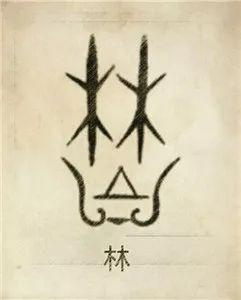The Lin(lín) surname is one of the most representative family names in China, carrying profound historical and cultural significance. From the loyal legacy of the Shang and Zhou dynasties to the diverse contributions in modern society, the Lin family has left an indelible mark on Chinese civilization.

Ⅰ、 Origins of the Lin Surname:
The Lin surname has diverse origins, with four main branches:
1. Zi Clan Origin:
During the late Shang Dynasty, Bi Gan, a loyal minister, was executed for criticizing King Zhou. His posthumous son, Quan (later named Lin Jian), was born in the Changlin Mountains. After the Zhou Dynasty overthrew the Shang, King Wu of Zhou granted the surname "Lin" to Lin Jian, honoring him as the founding ancestor. This branch is considered the most orthodox origin of the Lin surname.
2. Ji Clan Branch:
During the Eastern Zhou Dynasty, Ji Kai (styled Lin), a son of King Ping of Zhou, had descendants who adopted "Lin" as their surname, forming the Henan Lin lineage.
3. Official Title Origin:
The Western Zhou Dynasty established the position of "Lin Heng," responsible for forest conservation. Descendants of these officials adopted "Lin" as their surname.
4. Ethnic Assimilation:
During the Northern Wei Dynasty, the Xianbei tribe's Qiulin clan, and later the Manchu Bussa clan during the Qing Dynasty, adopted the Lin surname during their Sinicization, enriching the Lin family's heritage.
Ⅱ、Historical Figures:
The Lin family has produced numerous historical figures, embodying the values of loyalty and innovation:
1. Ancient Figures:
Lin Gao: A renowned prime minister of the Zhao State during the Warring States period.
Lin Pi: A Tang Dynasty official whose nine sons all became prefectural governors, earning the family the title "Nine Pastors of the Lin Family."
Lin Bu: A Song Dynasty poet known for his reclusive lifestyle and love of plum blossoms and cranes.
Lin Moniang (Mazu): A sea goddess from the Northern Song Dynasty, whose spirit of compassion has inspired a global following of over 200 million people, making her a symbol of Chinese maritime culture.
2. Modern Pioneers:
Lin Zexu: A Qing Dynasty official who led the fight against the opium trade and advocated for modernization.
Lin Juemin: A martyr of the 1911 Revolution, remembered for his poignant farewell letter to his wife.
Lin Boqu: An early leader of the Chinese Communist Party who played a key role in the founding of the People's Republic of China.
Lin Huiyin: A renowned architect and poet who contributed to the design of China's national emblem and the Monument to the People's Heroes.
Lin Yutang: A cultural ambassador whose works, such as Moment in Peking, introduced Chinese philosophy to the world.
Ⅲ、Cultural Significance:
1.Ancestral Halls and Clan Names:
The Lin family is associated with ancestral halls and clan names like "Xihe," "Jinan," and "Jiuan," reflecting their regional and moral legacy.
2.Totem Philosophy:
The Lin family's totem features twin trees ("Jianmu"), symbolizing the connection between heaven and earth and the cyclical nature of life. This imagery reflects the family's unity and reverence for nature.
3.Literature and Art:
The Lin family has produced many literary and artistic figures, such as Lin Shu, a pioneer in translation literature, and Lin Fengmian, a master of modern Chinese painting.
Ⅳ、Social Impact:
1.Population Distribution:
Today, there are approximately 14 million people with the Lin surname. The surname is concentrated in Fujian, Guangdong, and Taiwan, forming a "Lin Corridor" along China's southeastern coast.
2.Overseas Influence:
The Lin family has a significant presence among overseas Chinese communities, particularly in Southeast Asia. The Lin Clan Ancestral Hall in Singapore serves as a hub for transnational family networks, fostering economic and cultural ties.
3.Modern Contributions:
From Lin Huiyin's architectural achievements to Sudono Salim's (Lin Shaoliang) business empire in Indonesia, the Lin family continues to make significant contributions across various fields.
Conclusion
The history of the Lin surname is an epic of loyalty, migration, and innovation. Like a deeply rooted tree, it has grown from the ancient bloodline of the Shang and Zhou dynasties to the universal love of Mazu, and from poetic architecture to reformist zeal. This 3,000-year-old legacy is a microcosm of the enduring spirit of Chinese culture.